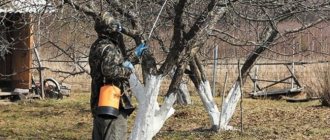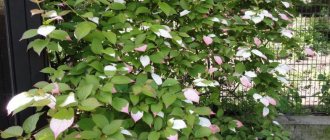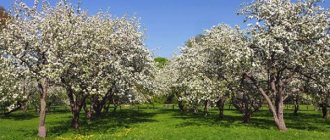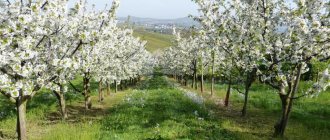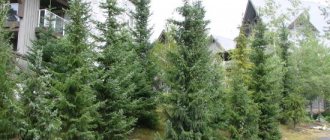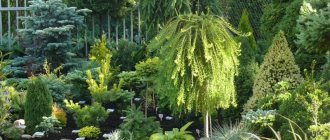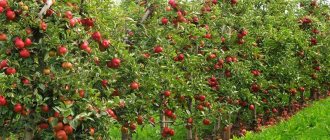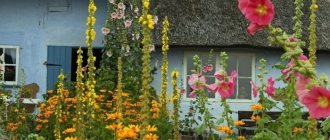For the purpose of designing a personal plot, various plants are used. Fast-growing trees allow you to get quick results in a short period of time. With their help, a garden or dacha will be landscaped in a relatively short time. Such crops are characterized by intensive development. Over the course of a year, they can grow from 0.5 m to 2.0 m. You may not have to wait for results for many years; to do this, you need to know all the features that these plants have, take into account their power and growth rate.
Classification of fast-growing trees
When selecting plants, special attention should be paid to such characteristics as length and width. The growth criterion is determined by the rate of growth of young shoots and the size of the trunk during the year. According to these values, fast-growing trees are classified according to the rate of annual growth:
- Up to 25 cm. This is a category of very slowly growing trees. These include common juniper, evergreen boxwood, and dwarf forms of larch.
- From 25 to 50 cm. Forest apple, Ussuri pear, sea buckthorn, cedar and magnolia are prominent representatives of slow-growing plants.
- From 50 to 100 cm. Quince, Siberian fir, common linden, western thuja, maple, and lilac grow moderately in nature.
- Up to 200 cm. Fast-growing crops include pine, bird cherry, walnut, and common viburnum.
- About 200 cm. Trees of super-intensive development are pyramidal poplar, aspen, birch, white acacia, and willow.
Fast-growing breeds surprise with their diversity. With the help of landscape design you can make a plot of land original and unique.
Interesting! Read the article about the great maple tree.
Characteristics and features of hedge shrubs
| Shrub name | Difficulty of care | Evergreen or not | Flowering | Perennial | Notes |
| Dogwood | Average | No | Yes | Yes | There are more than 50 species of dogwood. Grows quickly. |
| Bladderwort | Simple | No | Yes | Yes | About 20 varieties. Fast growing. |
| Snowberry | Simple | No | Yes | Yes | 15 types of shrubs. Refers to fast growing. |
| Thuja | Average | Yes | No | Yes | More than 100 varieties. It grows slowly. |
| Boxwood | Simple | Yes | No | Yes | More than 100 species. The shrub grows slowly. |
| Juniper | Simple | Yes | No | Yes | About 70 species are found in nature, of which 15 are cultivated. It grows slowly. |
| Kalmiya | Average | Yes | Yes | Yes | There are 10 species of shrubs belonging to this genus. Grows quickly. |
| Spirea | Simple | No | Yes | Yes | There are 90 species of spirea. It has spectacular flowering. |
| Caragana shrub | Simple | No | Yes | There are annual and perennial varieties | The genus Caragana includes 70 species. Growing actively. |
| Derain | Simple | No | Yes | Yes | More than 10 types. Grows at an average speed. |
| Rose hip | Average | No | Yes | There are annual and perennial varieties | More than 50 species grow in Russia, and there are more than 300 in the world. It grows quickly. |
| Blackberry | Simple | No | Yes | There are annual and perennial varieties | More than 200 species. Grows quickly, needs additional support. |
| Mahonia | Average | Yes | Yes | Yes | More than 50 types of mahonia. It grows slowly. |
| Forsythia | Complex | No | Yes | Yes | There are 6 known types of forsythia, the most popular is European. It grows slowly. |
| Barberry | Simple | There are deciduous and evergreen varieties | Yes | Yes | More than 100 types of barberry. Unpretentious, grows quickly. |
Selecting Fast-Growing Breeds
It is better to purchase seedlings in nurseries, at fairs or specialized exhibitions. They will always tell you which plants are growing rapidly and how to care for them. When choosing the tree you like, you should pay attention to the following factors:
- Magnitude _ To determine the area for planting, you need to know the diameter of the crop’s trunk in adulthood. Freedom is needed for full development.
- Growth . Knowing how quickly a tree will grow will allow you to imagine its maximum size in the future.
- Crown shape . This indicator is important both from a practical and decorative point of view. The choice of crown depends on the style of landscape design provided for by the project.
- Land area . Having studied the previous three factors, you can accurately calculate the optimal number of trees that can be planted on a plot of land.
- Soil composition. If the soil composition is not suitable or groundwater is close to the surface, this will lead to the death of the crop.
- Climate. This is important for the middle zone, where frosty weather arrives early. To prevent plants from freezing, it is necessary to choose winter-hardy ones.
It is important to decide for what purpose the crops are acquired. Ornamental shrubs and species such as lilac, hawthorn, and willow are perfect for living fencing. They grow rapidly and tolerate constant pruning well.
Provided that fast-growing trees are selected correctly, any cottage or garden plot can be beautifully landscaped in the shortest possible time.
Black elderberry
Another fast-growing shrub that looks very decorative and interesting throughout the season. Key features of the plant:
- The height of the bushes reaches 3-4 m;
- The inflorescences are lush corymbose;
- The fruits vary: from black to creamy-golden with a slight blush;
- It tolerates frost well, so it does not require additional shelter for the winter.
An ideal option for planting in areas of the Moscow region and the middle zone. Even if the black elderberry suffers from frost in winter, it can be cut into a stump in the spring. The bush will recover as quickly as possible.
Fruit trees
A personal plot implies the presence of fruit crops, the main task of which is to delight every spring with beautiful flowers and aroma, and in the summer or autumn with a fruit harvest. The following types are popular:
| Name | Annual growth, m | Maximum height, m | diameter , cm | Average life expectancy, years |
| Apricot | 1-1,5 | up to 12 | 30–60 | 30–40 |
| Plum | up to 2 | up to 15 | 40 | 15–60 |
| Cherries | up to 1 | 10–15 | 60 | 25–30 |
| Walnut | 1,5 | 15–30 | 200 | 400–600 |
There are differences in planting and caring for fruit crops. You should clearly know which breeds produce high yields, adapt well, bear fruit regularly, are resistant to diseases and pests, have excellent taste and beautiful appearance in this area.
When selecting plants for the garden:
- It is necessary to inquire about the resistance of crops to adverse weather conditions.
- Take into account the relationship of fruit crops to soil, humidity, and light.
Therefore, special varieties have been bred for each region.
It is important to choose the right planting material to ensure the survival of fruit trees and to obtain a high yield in a short time.
Read an interesting article about the Columnar apple tree.
Trimming hedge bushes
Haircut and pruning are basic hedge care activities. They help preserve the beauty of the composition and the health of the plants. It is very important to perform pruning at a strictly established period for each shrub, otherwise you can simply destroy the plant.
First pruning of bushes in a hedge
Trimming after planting promotes the development of a strong root system and stimulates shoot growth:
- For deciduous plants. During the pruning process, dry and weak shoots are removed. A spreading bush is cut at a height of 35-40 cm, weak plants - at a height of 15 cm. Approximately 1/3 of the length of the seedlings is left. If the hedge was planted in the fall, pruning is done in the spring. A hedge formed in spring or summer can be tidied up after planting.
- For coniferous plants. These shrubs have well-formed crowns, so they are not pruned in the first year. If necessary, only damaged and dried shoots are removed in July-August.
| Shrubs | Trim time | How to trim | |
| Krona | Lateral sprouts | ||
| Deciduous | If planted in autumn, prune in spring; If planted in spring/summer - a week after planting | 30 – 35 cm above the ground | 15 cm |
| Conifers | July - early August, no earlier than a year after planting | The tops are cut off by 10-15 cm | 5-10 cm |
Useful tips for gardeners
- If the hedge has a complex shape, it is better for beginners to cut it according to a template - it is made from cardboard or chipboard.
- Coniferous hedges are pruned in July-August. In the fall, the shoots are not touched, otherwise they may not have time to come into force and will suffer from the cold.
- If you trim your hedge frequently, you will need to apply fertilizer. The optimal period is early spring. You can use both compost and multi-component fertilizers.
- You will need the following tools: pruning shears, loppers (for thick branches), electric shears (for forming a hedge). It is important that the tool fits comfortably in your hand and is not heavy.
Pruning when the hedge has grown
To make the hedge look neat and well-groomed, it needs to be trimmed. Deciduous bushes are pruned twice a year, coniferous bushes - once a year as necessary (if the plants do not grow well). If the hedge is unshaped, it is enough to trim it in the spring. Then the branches will grow thicker, but the shape of the bush will remain natural.
Molded deciduous hedges are trimmed once a month. Coniferous - twice a year, in spring and summer. Columnar-shaped shrubs are practically not pruned. Once every few years, thinning the crowns of deciduous plants is carried out - this procedure should be carried out in early spring before the buds appear. Old shoots are removed, and new shoots are cut by a third.
Important! You need to understand the difference between cutting and trimming. Trimming is simply maintaining the desired shape of the hedge, pruning is a procedure for caring for the plant. Pruning involves removing excess branches for more intensive growth and density.
Deciduous crops
In a short time, you can green up a recreation area on your personal plot by planting fast-growing deciduous trees. Now these are the main landscapers of the whole country. The leaves and flowers of some of them secrete phytoncides that disinfect the air. In just 2–3 years they will provide dense greenery and abundant shade. Most Popular:
| Name | Annual growth, m | Maximum height, m | diameter , cm | Average life expectancy, years |
| Birch | up to 2 | up to 45 | 50–70 | 300 |
| White acacia | up to 1.5 | until 25–30 | 30–40 | up to 50 |
| Willow | 0,5-1,0 | 15–40 | up to 100 | 20–150 |
| Maple | up to 2 | 30 | up to 100 | 200 |
| Poplar | more than 2 | 40 | up to 300 | up to 400 |
Deciduous crops adapt well to changing weather conditions. Some beneficial substances of these trees are used in medicine. It is better to plant seedlings in the fall. At the initial stage of growth, they need frequent and abundant watering. After successful rooting, they produce strong shoots next year.
We advise you to read about an unusual tree - catalpa bignoniiformes.
The idea of “your own forest” with deciduous trees several tens of meters long is unlikely to occur to a person with a traditional six hundred square meters.
Deciduous trees are a real plus: they don’t cause trouble; beautiful; protect from piercing winds; retain snow in winter; create shade in hot weather.
Decorative flowering indoor flowers
Flowering types of indoor plants, characterized by rapid growth, are especially popular. Almost all specimens delight the eye not only with their leaf mass, but also with their spectacular flowering .
Hibiscus
The decorative flowering shrub hibiscus, or Chinese rose, has a tree-like crown with many shoots.
Its large bright flowers bloom at the tops of the shoots; they can be simple or double.
The inflorescence of hibiscus is single, funnel-shaped, and the fused stamens and pistil protrude beyond the flower.
Passionflower
This flower has unusually beautiful leaves and flowers of bizarre shapes of various colors. The plant is a liana , the length of which can reach several meters even in a room.
The dense leathery leaves are dark in color, and the star-shaped flowers amaze with the magnificence of the transition of shades - bright blue, light blue or purple.
Begonia everblooming
This small herbaceous plant has waxy leaves on compact stems. The flowers of this plant, although small, look very decorative.
Begonia blooms profusely and can last almost all year round.
Abutilone
Abutilon is popularly nicknamed indoor maple due to the similarity of the shape of the leaves . The flowers of this plant are large, bell-shaped on a thin stem.
The main color scheme is yellow and shades of pink and red.
Conifers
Over the past few years, it has been popular to decorate garden plots with fast-growing coniferous trees. Thanks to their coniferous leaves and trunk shape, they are used in creating landscape compositions. Plants are unpretentious, therefore they have a number of advantages:
- Fir. These trees rank first in beauty among conifers and are a favorite shelter for animals in the taiga. They grow rapidly and tolerate the absence of light and heat well. The plant has a straight trunk with a pyramidal crown. Among other conifers, fir is recognized by its cones sitting vertically on its branches. In nature, some trees reach 80 m in height. Therefore, decorative views will bring aesthetic pleasure to your dacha.
- Cedar. One of the most ancient plants, which is a symbol of power. It usually lives up to 250 years and grows up to 50 m in height. The trunk of mature trees reaches 2 m in diameter. Siberian and European cedar are suitable for home planting. How long a tree grows depends on the lighting conditions.
- Larch. This is a powerful tree up to 40 m in height. In autumn the plant turns bright orange and yellow, and before winter it loses its needles. Lives more than 500 years. Larch can withstand very low temperatures and can grow even in permafrost. In home gardens, trees are represented by miniature varieties.
- Thuja. It is represented by evergreen coniferous trees. This plant lives for more than 150 years. In natural conditions, the height of the thuja can reach 70 m, and the trunk diameter up to 6 m. In garden culture, the thuja grows up to 11 m. It is an unpretentious, winter-hardy breed with original leaves. The shape of the thuja is spherical or columnar.
Gardeners love coniferous trees because they grow well in limited sunlight, can survive for long periods without watering, and grow on rocky soils.
Buddleya David
The exotic shrub Buddleia Davida is a leader among plants that, with proper care and choice of location, provide excellent growth of shoots.
The average increase in stems per season is 2-2.5 m. Note! To prevent the shoots from stretching out and becoming bare, the bush is regularly pruned to give the desired shape. Tall varieties in the spring are pruned to 90 cm from the ground level, low-growing varieties - to 30 cm. Regular pruning stimulates more luxuriant flowering.
Buddleia reaches a height of 2.5-3 m, the branches are drooping, densely covered with small and green leaves. Blooms from May to late summer. The color of the inflorescences depends on the variety. Prefers well-lit areas without drafts. It grows and develops well in moist, well-fertilized soil. The plant is heat-loving, so insulation is necessary for the winter.
How to decorate your garden plot
It is important for the owner who owns the land that his territory always remains picturesque and attractive. Fast-growing trees can perform this function perfectly.
Special attention is paid to fruit crops in landscape design. There are specific planting patterns that depend on the style and size of the area. Their advantage is fertility, and therefore usefulness. Once the crops have been selected, planning of the functional composition begins. You can plant an alley of fruit trees or a hedge. In small areas it is more correct to adhere to the landscape style.
When choosing deciduous crops for decoration, we must remember that by winter almost all of them lose their appearance. The impression of them is created by the color and shape of the foliage, and the aroma of the flowers. Their appearance during the season is important. When choosing deciduous trees, take into account their adult size and requirements for climatic conditions. A wall is formed from tall trees, and the foreground of the composition from low-growing trees.
The unusual shape of the crown and leaves of conifers gives the place a southern flavor. Due to their monumentality, they form the basis of the entire composition. Particular importance is given to the color and texture of the needles. To make the composition look harmonious, a well-groomed lawn is left as a background. Trees should be oriented to the west or east, and contrast in their sizes and shapes will help achieve visual effects.
Lilac
A very common shrub with rapid shoot growth rates. The description here is superfluous, since almost everyone always has a lilac bush growing near their house. The plant blooms profusely from early May to June. The color of the inflorescences depends on the variety.
Lilac is unpretentious and is not afraid of frost. It is best to plant in a well-lit or slightly shaded area. There are no soil requirements.
On a note! For lush flowering, it is necessary to carry out sanitary pruning every time during the formation of buds, leaving 10-15 strong shoots.
